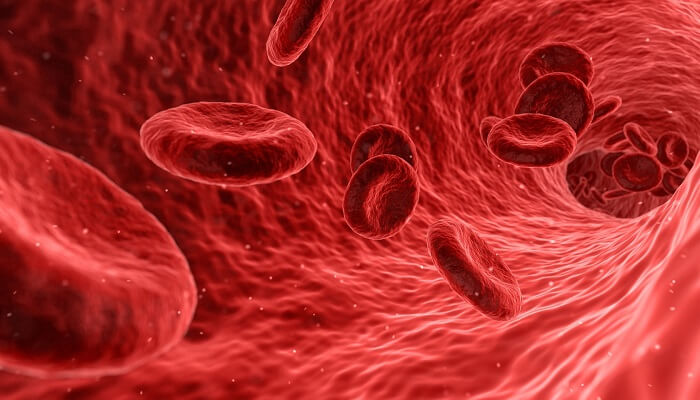Did you know that the #1 leading cause of death for men and women is heart disease?1 Due to the prevalence of this disease, ensuring that the cardiovascular system is functioning properly should be a top priority for everyone.
Our cardiovascular system is a vital part of the body that has many essential responsibilities. It allows us to function in our day-to-day lives and ultimately keeps us alive. When the cardiovascular system isn’t taken care of, it can lead to serious risks and side-effects.
In order to understand why we need to take such good care of our heart health, it is important to know what the cardiovascular system is and what it really does. Read on to learn all about this essential body system and what you can do to keep it healthy.
Your body’s cardiovascular system is made up of 3 main parts: the blood itself, the heart, and the blood vessels. The heart and blood vessels circulate blood through the body so that it can deliver and pick up oxygen, nutrients, and waste from all of your body parts.
Blood is a fluid that is designed to transport substances in your body (including vital things like proteins, nutrients, hormones, antibodies, and oxygen) so that they can be delivered to where they are needed.
The heart pumps blood throughout your body. This organ is controlled by electrical signals that tell it to beat. When it beats, it pumps blood into the arteries and carries it to all of your organs and body structures.2 3
The heart works closely with the lungs. Blood is circulated between the heart and lungs in order to become oxygenated.
Your blood vessels make up your circulatory system, which is a network of vessels through which blood circulates in the body. By carrying blood, your blood vessels are able to transport oxygen, nutrients, and waste to and from various body parts. The 3 types of blood vessels are arteries, capillaries, and veins:
The circulatory system actually has two parts: the short loop that goes from the heart to the lungs to oxygenate your blood and remove carbon dioxide (called pulmonary circulation), and the larger network that sends blood from the heart to all of our other body parts and back again (called systemic circulation).4

The main purpose of the cardiovascular system is to circulate blood throughout the body.3
Blood leaving your heart via your arteries carries oxygen, nutrients, and other vital substances. As your heart pumps it out, the blood is able to travel everywhere that those substances are needed. Then, as the blood continues to circulate and returns to the heart, the cardiovascular system helps you to remove waste matter from your cells so that it can be properly disposed of.2 3
The cardiovascular system works very closely with many of your other body systems and has many other important functions in the body.
For example, it works closely with your digestive system. As your food is digested and nutrients are released from the food, your blood picks up these nutrients so that they can move to the parts of the body where they are needed. The blood also carries hormones (our body’s chemical messengers) throughout the body so that our different body systems can communicate and work in harmony. Another important function of the cardiovascular system is temperature control; one way the body regulates its temperature is through the flow of blood to different parts of the body.2 4
The cardiovascular system includes the heart, which has several energetic connections throughout the body. This includes the pituitary gland, small intestine, and several vertebrae. The heart is also closely connected with the 4 back teeth known as the wisdom teeth, which in turn have a connection to emotions such as grief and loneliness.
Other emotions that have an energetic connection to the cardiovascular system include anxiety, sadness, and anger. Thus, it is important to consider these related emotions, organs, vertebrae, and teeth when looking at this system, as they can both impact and be impacted by cardiovascular health.
As with any body system, there are many different ways that things can go wrong within the cardiovascular system. When that happens, it can lead to various symptoms and conditions.
Common cardiovascular problems can affect either the heart itself (and its ability to pump blood) or the blood vessels (and their ability to carry blood throughout the body uninhibited).

Here are some common examples of cardiovascular conditions:
The symptoms of cardiovascular disease can vary widely based on the type of condition you have and whether or not you are experiencing an acute cardiovascular event like a stroke or heart attack.
The symptoms of cardiovascular problems can include:
While cardiovascular symptoms can be quite serious, there is hope to prevent the risks and dangers associated with them. And there is a lot you can do to stay healthy in the long term. Much of that comes down to choosing healthy lifestyle and dietary habits.

Common risk factors for cardiovascular disease include smoking, physical inactivity, excessive alcohol intake, obesity, diabetes, high cholesterol, and high blood pressure.5 6
Luckily, cardiovascular disease can often be prevented with behavioral habits and lifestyle modifications that limit your risk.1
Here are some of the most important lifestyle tips for keeping your heart and circulatory system happy and healthy:
These types of lifestyle changes can make a huge difference and can reduce your risk of serious problems including high blood pressure, artery disease, heart attack, and even mortality from cardiovascular conditions.7 8 12 In a study on over 55,000 people at high risk for coronary artery diseases, for example, favorable lifestyle habits reduced the risk of coronary artery disease by about 50%.9
How you eat is another important thing to pay attention to if you want to keep your cardiovascular health in good shape and prevent any problems down the road.
Certain dietary patterns (like eating junk food loaded with sugar) can contribute to heart problems, whereas others (like eating greens and omega 3-rich salmon) can reduce your risk.
Here are some tips to keep in mind:

In addition to healthy lifestyle habits and dietary patterns, there are also some heart-healthy supplements, herbs, and oils you can add to your routine to support your cardiovascular health.
Here are a few examples that may be worth considering:
A digital signature representing the cardiovascular system is automatically scanned in the Balance biosurvey and can also be selected and scanned in various Select and Elite biosurveys. Along with scanning this category, there are items within the Cardiovascular System Virtual Item that are scanned. Some of the items within this category are:
In addition to this category, the Select and Elite software allow you to scan for a related category called Channel B: Tissues – Cardiovascular System. This category includes Virtual Items such as Blood, Heart Valves, Heart Muscle, and Vascular System.
After scanning the Cardiovascular System and other stressor digital signatures, a balancer scan of selected products, services, and/or lifestyle-related items typically follows. A balancer re-scan shows which items brought the out-of-range, or out of balance, stressors back into range.
If the Cardiovascular System was out of range, you can see which product Virtual Item brought it back into range on the Biomarker Progress Chart, which is displayed in the Advanced Report in the Balance. And although they don’t directly bring the Cardiovascular System back into range, service items for which the body showed a strong biological coherence may assist with supporting this system as well.
Of course, emotions play a large role in the health of any body system, and this is where ZYTO EVOX perception reframing can be a tremendous help. With the EVOX, you can address the underlying emotions that are energetically connected to the cardiovascular system such as anxiety, anger, and grief.
 About Chelsea Clark
About Chelsea Clark
Chelsea Clark is a writer and certified health and wellness coach who is passionate about supporting others along their own health journeys. She enjoys helping people make positive, lasting changes so that they can live the happiest, healthiest life possible.
Sources:
1. “Cardiovascular Diseases (CVDs).” World Health Organization. Who.int.
2. “Overview of the Vascular System.” Johns Hopkins Medicine. Hopkinsmedicine.org.
3. Chaudhry R., J.H. Miao, & A. Rehman. “Physiology, Cardiovascular.” (2020).
4. “Heart and Circulatory System.” KidsHealth. Kidshealth.org.
5. Institute of Medicine (US) Committee on a National Surveillance System for Cardiovascular and Select Chronic Diseases. “Cardiovascular Disease.” A Nationwide Framework for Surveillance of Cardiovascular and Chronic Lung Diseases. (2011).
6. “About Heart Disease.” Centers for Disease Control and Prevention. CDC.gov.
7. “Heart-Healthy Living.” National Institutes of Health. Nhlbi.nih.gov.
8. “Adopting a Heart-Healthy Lifestyle.” UC San Diego Health. Health.ucsd.edu.
9. Khera A.V., C.A. Emdin, I. Drake, et al. “Genetic Risk, Adherence to a Healthy Lifestyle, and Coronary Disease.” N Engl J Med 375, no 24 (2016):2349-2358.
10. Sin, N.L. “The Protective Role of Positive Well-Being in Cardiovascular Disease: Review of Current Evidence, Mechanisms, and Clinical Implications.” Current cardiology reports 18, no 11 (2016): 106
11. “Lifestyle changes to lower heart disease risk.” Harvard Medical School. Health.harvard.edu.
12. Brinks J., A. Fowler, B.A. Franklin, & J. Dulai. “Lifestyle Modification in Secondary Prevention: Beyond Pharmacotherapy.” Am J Lifestyle Med 11, no 2 (2016): 137-152.
13. “Intensive lifestyle change: It works, and it’s more than diet and exercise.” Harvard Medical School. Health.harvard.edu.
14. “The Truth About Fish Oil, Omega-3 Fatty Acids, and Heart Health.” Penn Medicine. Pennmedicine.org.
15. “Top Herbs for Your Heart.” Cleveland Heart Lab. Clevelandheartlab.com.
16. Seol, G.G., & Y.K. Shin. “Essential Oils and Factors Related to Cardiovascular Diseases.” Potential of Essential Oils (2018): 129-144.
17. Evans, R. “Essential Oils for Heart Health: What You Need to Know.” Healthline.com.